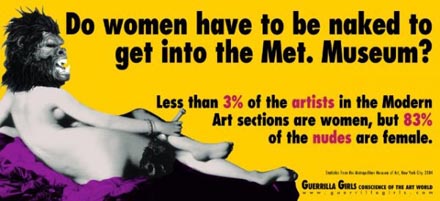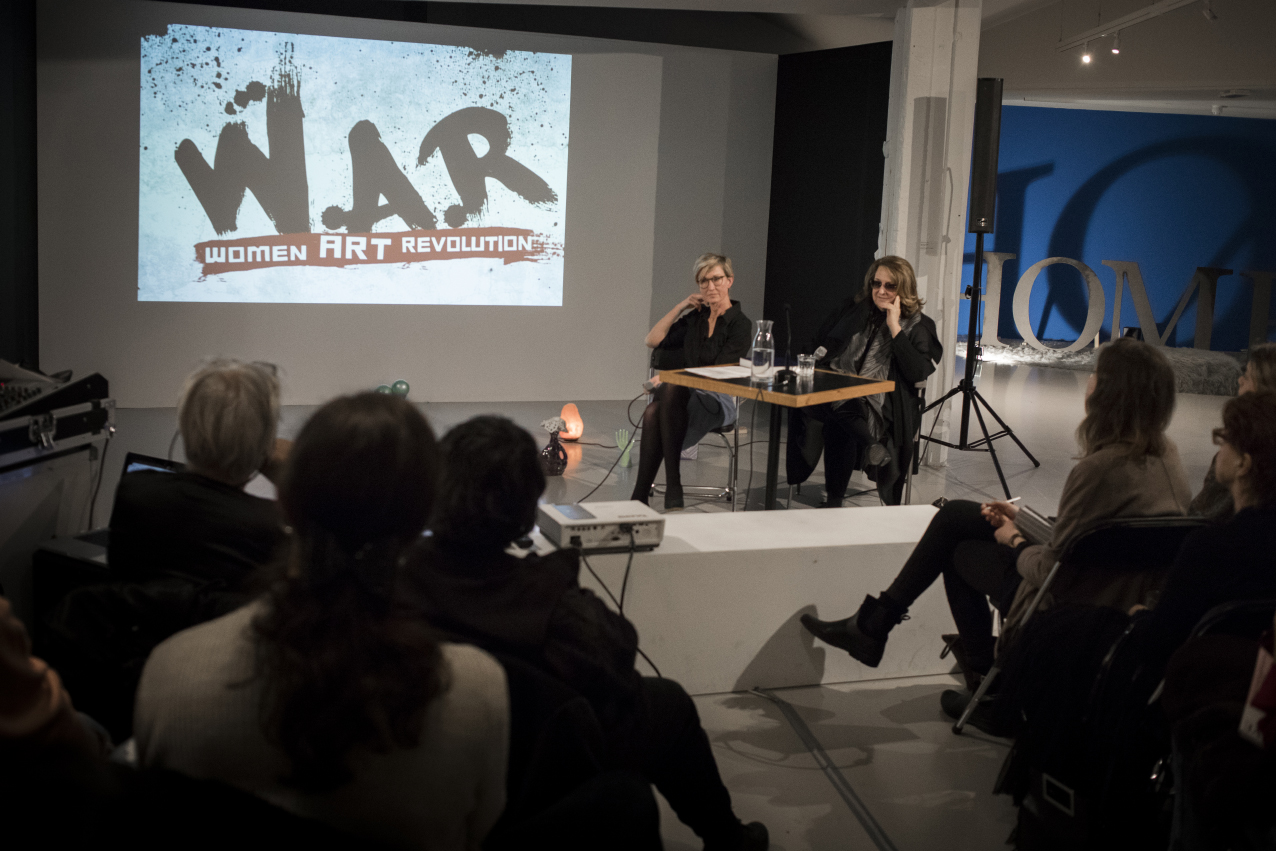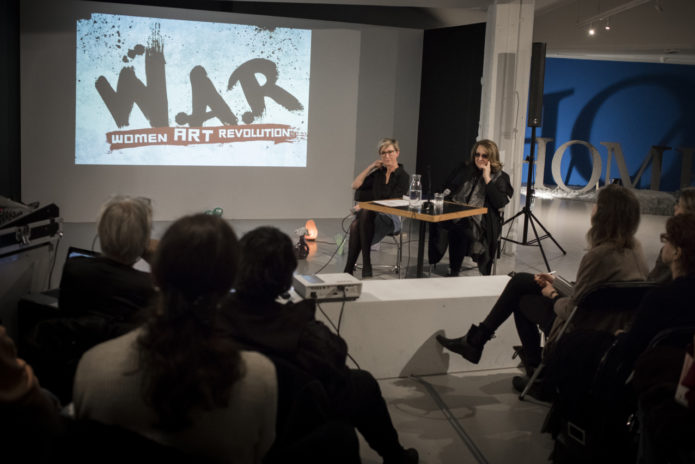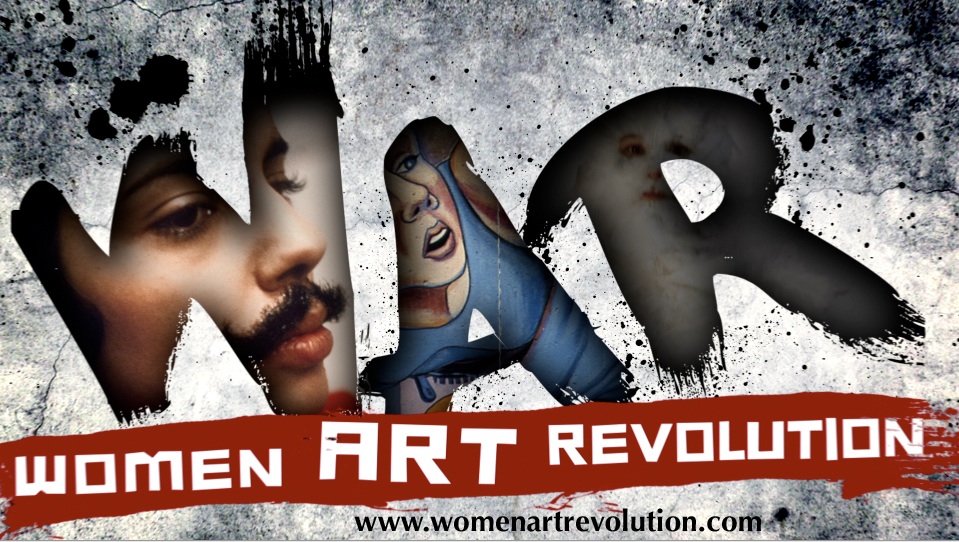 Documentaire: !Women Art Revolution - Asking and telling about the Feminist Art Movement
Documentaire: !Women Art Revolution - Asking and telling about the Feminist Art Movement Documentaire: !Women Art Revolution - Asking and telling about the Feminist Art Movement
The realization that most people within the general public would have a hard time to recall the names of more than three female artists is both painful and poignant, highlighting at once the importance of the documentary !Women Art Revolution. !W.A.R (for short) is a narrative created from forty-two years worth of footage of people that passed through director Lynn Hershman Leeson’s home since 1966. Hershman rediscovered the footage in 2004 en decided to forge the material into something that would document one of the most important art movements of the twentieth century: the Feminist Art Movement. Lynn Hershman Leeson is herself an artist, who has worked with site specific, performance and interactive media art and who has written, produced and directed several films and shorts. Having been part of the movement, she felt compelled to use the material to honor the Feminist Art Movement and the struggles it went through.1 While the documentary was released in 2010, it is still as relevant as it has ever been, with current research still showing disparities between the representation and sale of male and female artists.2
The documentary, distributed by Zeitgeist Films, is a record of the Feminist Art Movement that shows the context, struggles, and diversity of a movement that tried to change the established art world. From the 1960’s onward, the Feminist Art Movement challenged the dominant white male hegemony that commanded the art world at large and which structurally excluded women artists and female perspectives from the museums, galleries and art courses. While !W.A.R. does not explicitly cover it, the exclusion of female artists from arts institutions has been part and parcel of the dominant male hegemony. As Linda Nochlin noted in her groundbreaking essay Why have there been no GREAT women artists? women have (almost) always been excluded from the social and professional circumstances essential to achieve any genius in art.3 This longstanding disregard towards female artists culminated into an artistic environment that, when women tried to enter and establish their equality, acted patronizing, debilitating, and hostile. The Feminist Art Movement challenged this as well as actively attempted to create the opportunities that so many women had been denied. The documentary shows how the establishment of an environment of male dominance has skewed the perception and creation of art and created a world where the female perspective was simply not valid.
Leeson shows how the struggles related to the broader debates and events in society, like the Vietnam War, the Black Panthers and the Civil Rights Movement, and how these broader debates also reflected upon the movement. She creates an evocative image of a climate of oppression in which these female artists had a choice: to deny their gender completely or to make a stand through it. As a matter of course the actions of the movement – setting up galleries, courses, exhibits and protests – led to reactions, backlash and at times internal conflict. All this is present in Hershman’s absorbing documentary, which features a broad mix of artistic characters ranging from the prominent Judy Chicago to Arlene Raven, Miriam Schapiro and many others. Not just the movement, also art is addressed; short clips giving a good idea of the art that was made with so much ambition and ideal. The feature doesn’t just cover the beginning and initial heyday of the movement in the 60s and 70s: the further developments are also discussed, albeit in less detail. Even some contemporary artists who work in the feminist vein are shown to demonstrate the current relevance of the art that is made within the scope of these ideas and the visual language.
While the documentary is by now three years old and more than forty years removed from the vestiges of the Feminist Art Movement, its relevance has hardly diminished. As if those last forty years never happened, male dominance is still rife in the arts, proven by the recent public statement by artist Georg Baselitz that women artists just cannot paint and that is why there haven’t been any great women artists.4 Additionally, recent figures about the exposure and sale of the artwork of female artists still shows a discrepancy between prices fetched and media coverage allowed to male and female artists.5 While there are also positive developments, with an increasing number of one women shows in museums and galleries and female curators getting more possibilities to curate high-end exhibitions and events, we are simply not there yet.6
Having lauded the documentary as inventive, engaging and relevant, however, does not mean that there are no points that could have been improved. As pointed out, the social background for the exclusion of women is not discussed. This isn’t as much a problem as a mere artistic choice. After all, it is a documentary about the Feminist Art Movement, not the history of female exclusion. However, a slightly broader focus on the experience of the doubly disadvantaged groups, female minorities, would have given credit to the documentary. As it is, the documentary does feature some female artists from a non-American background – for example, Ana Mendietta and Howardena Pindell – but avoids an extensive discussion of the perspective of those who experienced this additional factor. Furthermore, the focus is solely on the Feminist Art Movement within the U.S. borders, with not so much as a glance across the borders. Another point of interest that might have also added to the ciritcal position of !W.A.R., is the extent of the effect of the movement. While the relationship is not spelled out in the documentary, there is a connection between the development of the feminist art movement, their struggle with the art institutions and the development of New Museology. New Museology developed from the 1970s and 1980s and affected a change in the art institutions, which was geared towards making then less elitist and exclusionary.7 The relationship between the museum and broader society became a focuspoint in calls for change in the museum, both from society, academia and artists, a call that was also mirrored in the feminist art movement. Implicitly, !W.A.R. shows that the effect of the movement was rather one-sided in this respect: while the female artists were admitted into the canon, this canon was still firmly dominated by the white, male hegemony. This is poignantly clear in the interview with Marcia Tucker, where she narrates how she was offered to be one of the first female curators at a museum – at a lower pay than her male equivalent, of course.8 The movement was also hard-pressed to actuate any change in the reflexivity of the museum and its relationship with society. Art and social reflexivity stayed two different practices that remained incompatible. This is illustrated in the interview with artist Judith Baca when she explaines that her work in the community would always stay very separate from that in the museum – because there was just no way to reconcile the two.9
Overall, however, !W.A.R. is an empowering documentary that is extremely relevant and important as it deals with discrimination that a lot of female artists still face. It is composed with integrity, showing equal parts of social movement and internal drama and offering a podium to the arts that it is concerned with. The accompanying graphic novel and the website, which is set up like a continuous art work and database, as well as the possibility to watch all clips that Hershman shot through the website of Stanford are real complement to the documentary. I would strongly recommend this documentary to any student or enthusiast of art history and many besides.
Article by Anne van Dam
19 January 2014
Notes
1. Yerman, M. “!Women Art Revolution at MoMA”. Huffington Post, 14-03-2011. Accessed 2-09-2013
http://www.huffingtonpost.com/marcia-g-yerman/women-art-revolution-at-m_b_835434.html
2. Pollock, G. “How much does gender influence the art world?” The Telegraph, 17-07-2013. Accessed 02-09-2013
http://www.telegraph.co.uk/women/womens-life/10184705/How-much-does-gender-influence-the-art-world.html
3. Nochlin, L. “Why have there been no GREAT women artists?” ARTnews (1971): 13-14
4. Byer, S., Knöfel, E. “German Artist Georg Baselitz: ‘My Paintings are Battles’” Spiegel Online International. 25-01-2013. Accessed 02-09-2013
http://www.independent.co.uk/arts-entertainment/art/news/whats-the-biggest-problem-with-women-artists-none-of-them-can-actually-paint-says-georg-baselitz-8484019.html
5. Reilly, M., Nochlin, L. Global Feminisms. New Directions in Contemporary Art. London: Merrell Publishers, 2007: 18-19 & Elderton, L. “Redressing the Balance: Women in the Art World”. The White Review, 2013. Accessed 02-09-2013
http://www.thewhitereview.org/art/redressing-the-balance-women-in-the-art-world
6. Reilly, M., Nochlin, L. Global Feminisms. New Directions in Contemporary Art. London: Merrell Publishers, 2007: 17-19
7. Smith, C. S. ‘Museums, Artefacts, and Meanings’. In: Vergo, P (eds). The New Museology. London: Reaktion Books Ltd., 1989
8. Hershman, L. ‘Transcript of the Interview with Marcia Tucker.’. Standford University Digital Collections. 26-07-2006. Consulted on: 10-10-2013 http://lib.stanford.edu/women-art-revolution/transcript-interview-marcia-tucker
9. Hershman, L. ‘Transcript of the Interview with Judith Baca and Suzanne Lacy.’. Standford University Digital Collections. 27-07-2006. Consulted on: 10-10-2013 http://lib.stanford.edu/women-art-revolution/transcript-interview-judith-baca-suzanne-lacy
- Women Art Revolution
Links
Feminisme / Art economy /
Exposities
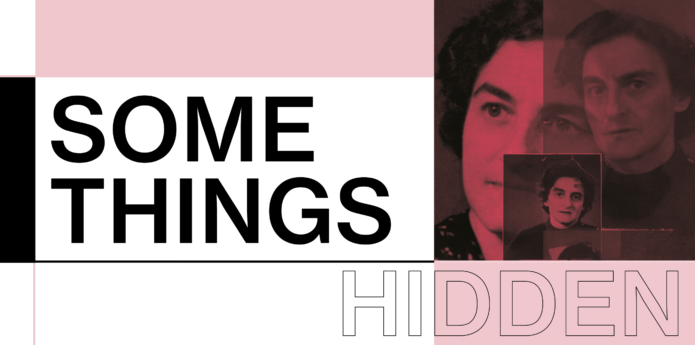
Expositie: Some Things Hidden
In samenwerking met Castrum Peregrini. Curatoren: Nina Folkersma en Charlott Markus
Agenda
Finissage: Some Things Hidden
Met een tour door Charlott Markus en een gesprek tussen kunstenaar Lynn Hershman Leeson & curator Nina Folkersma.
Netwerk

Lynn Hershman Leeson
Kunstenaar

